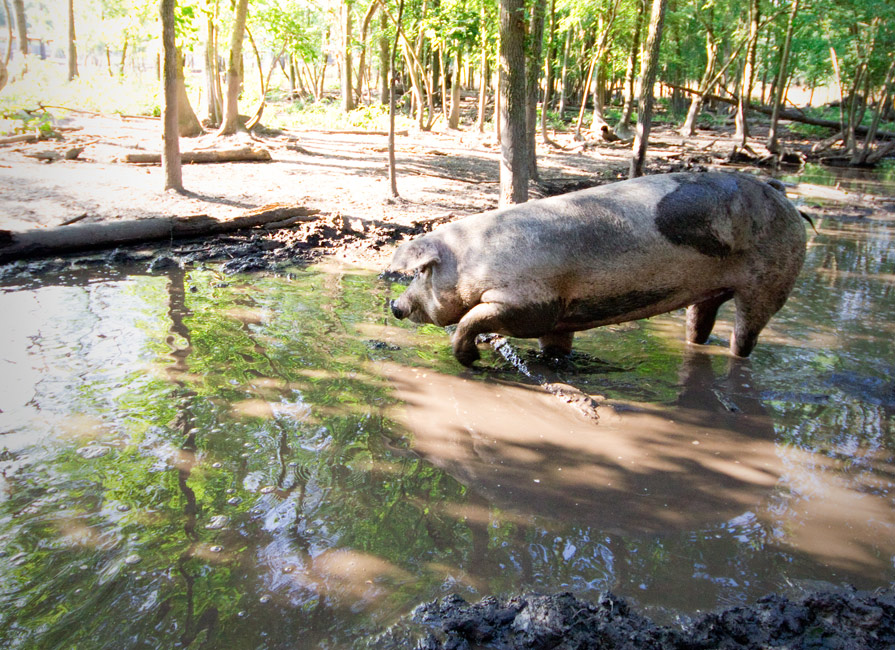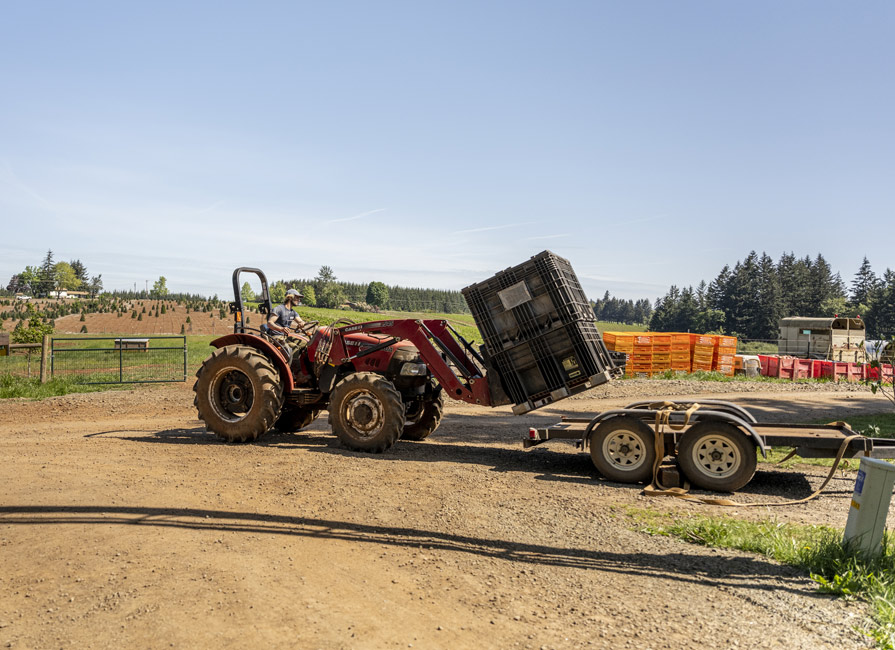One of the key attractions of our Certified Regenerative by AGW program is its practical…

Hog Roast
Despite the well-known saying, pigs don’t actually sweat (aside from their snouts) and can struggle to maintain their body temperature. Without proper management, heat stress in pigs can lead to reduced growth rates, fertility issues, and even death.
First, we need to get our terms clear. Sunburn and heat stress are two different conditions. Sunburn is caused by prolonged exposure to ultraviolet light from the sun, while heat stress is caused by the inability of the pig to cool down in hot/humid weather. Pastured pigs can suffer from both, with light skinned pigs more likely to suffer from sunburn and dark skinned pigs potentially more susceptible to heat stroke as their darker skin absorbs more heat.
Understanding heat stress
Heat stress in pigs can start at much lower temperatures than you might think, and is much more likely when air humidity is high. An additional factor is the temperature range your pigs are used to. Research suggests that pigs adapted to colder conditions can succumb to heat stress even with modest temperature increases.
According to one study, pastured sows started reacting adversely when temperatures reached 68ºF, while indoor sows did not react until temperatures reached 72–77ºF. However, temperature alone is not the best measure of heat risk—humidity levels significantly impact how pigs cope with heat. Heat stress index charts like the example for sows (see right) are a useful decision tool for management strategies to minimize heat stress risks.
Signs of heat stress
Pigs regulate body temperature through panting and through cooling its skin. Panting increases airflow and evaporates moisture from the lungs, releasing heat. Pigs will also lie on cool surfaces or in shaded areas to help dissipate heat from their bodies, or cover themselves in water or mud, which aids evaporative cooling and provides some protection against sunburn.
If your pigs are lying in the shade, panting heavily, drooling, or appear lethargic, they are likely suffering from heat stress. Going off feed is another classic sign. Pigs will markedly reduce their feed intake when too hot, as digestion generates additional heat. This can impact growth rates of market hogs and milk production in lactating sows.
Recent research shows even short-term heat stress (a few hours) can compromise immune function, making pigs more susceptible to disease. Heat stress can also lead to fertility loss in both boars and sows. Boar sperm volume and quality will decrease if the boar overheats—an issue you may only notice when sows return to estrus instead of conceiving. Heat stress in sows can cause early embryo death and reduced litter size. If you experience seasonal fluctuations in fertility, heat stress could be a factor.
Preventing heat stress
The most important action you can take is providing pigs with wallows where they can get a good coating of mud on their skins. If you don’t, pigs may move or break water troughs to create their own mud hole. It is far better to keep drinking water clean and wallowing water muddy, so providing two distinct areas is ideal.
A continuous supply of fresh, clean drinking water at all times is essential to pig health. Remember: warm drinking water does not have the same cooling effect as cold water. Think about:
- Positioning drinkers in shaded areas to keep water cooler.
- Burying plastic water pipes to prevent heating in the sun.
- Using insulated water storage to maintain a lower temperature.
Providing shade is just as important as water. This might be:
- Natural, such as trees and tall vegetation
- Man-made, such as shade cloths attached to poles or dedicated structures
- Well-ventilated huts.
While pigs still need comfortable places to lie down, you can safely reduce bedding quantity in hot weather.
If farrowing huts become too hot, sows may leave their litters to seek relief. If piglets are big enough to follow her you can provide nearby shade on the range. Otherwise, ensuring good ventilation is crucial to welfare.
If high summer temperatures are a regular occurrence, insulated huts that minimize interior heat are a worthwhile investment. Alternatively, Using heat-reflective paint or insulation can help keep interior temperatures down.
Finally, avoid feeding pigs in the hottest part of the day. Instead, feed them in the early morning and/or evening to reduce heat stress.
Pig size, color, and genetics
Larger pigs are more susceptible to heat stress because they generate more body heat. Optimum temperatures vary:
- Newborn piglets: circa 95°F
- Three-week-old piglets: circa 80°F
- Market-weight pigs (circa 75+lbs): circa 60°F
If a pig gets too far above its optimum temperature range it will suffer from heat stress. Pig color may also play a role. Although there is some concern that darker colored pigs might absorb more heat, in general smaller breeds with dark skin and long snouts are less susceptible, because they have a greater surface area per pound of body weight (meaning greater heat transfer), more pharynx area to allow cooling through panting, and natural pigment for protection against sunburn.
Interestingly, modern genetics have made pigs more heat-sensitive. Research suggests that new pig lines produce nearly 20% more body heat than pigs from the 1980s, making heat management even more critical.
Be prepared
Heat stress can significantly impact pig health, welfare, and profitability. Assess your pigs’ access to shade, water, and cooling strategies now before summer temperatures rise. Taking proactive steps now will protect your pigs—and your bottom line.
Author: Anna Heaton was a former Lead Technical Advisor for AGW
Originally published in the Spring 2025 issue of AGW’s Sustainable Farming magazine.


